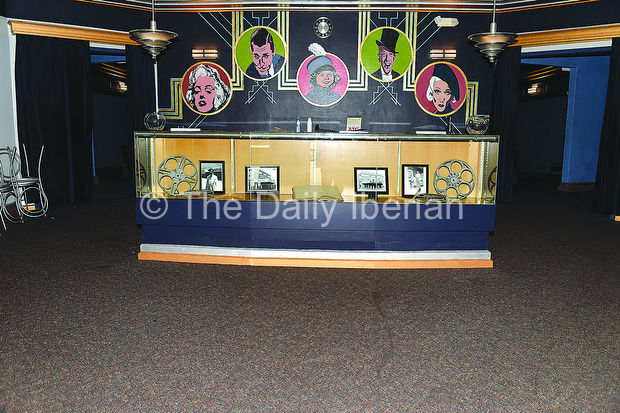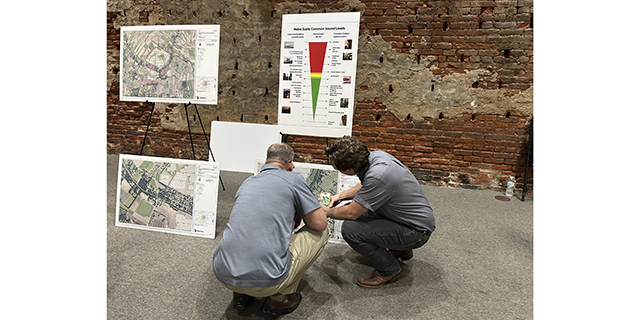Behind the ‘seen’
Published 5:53 pm Wednesday, September 2, 2015

- A new mural in the Essanee Theater lobby honors its roots as a movie theater. The artist was Jimmy Rink.
The art of authentic design on philanthropic budgets
The new season for Iberia Performing Arts League will soon begin with the opening Sept. 10 of “A Raisin in the Sun.” Yet, the celebration of recent redecorations will continue for generations.
Changes to the Essanee Theater environment were completed at the end of last season and a recent tour with Doc Voorhies brought to light how substantial the program is to the community as well as arts in Iberia Parish.
“Glenn Conrad reported in one of his books that since 1923, five theater groups didn’t survive in New Iberia,” said Doc Voorhies. “None stayed open because they didn’t have a permanent home.”
Voorhies is the unofficial, historic tour guide for Essanee Theater, a community project close to his heart. He said his research of the building and theater history draws from the earliest days and in particular since records of others stopped, sometime around 1972. Essanee Theater was one of the most popular places to go, he said, because from the beginning, in 1937, it had air conditioning.
The method of cooling the building was unique and found in few other buildings, Voorhies said. The basement which is 10 feet below ground and extends half the length of the theater space, would be filled with ice weekly. Huge fans would then blow cold air into the theater for the comfort of patrons. A sump pump would keep the water pumped out as the ice melted.
The building itself, Voorhies said, is not on the National Register of Historic Places. It just sits in a historic district.
The building continuously ran as a movie theater from 1937 until it closed in 1982. The old projectors and marquee letters are in the upper balcony room where they have always been housed. The area is now used for storage, but the room is as it was.
“Freddie Decourt bought and stabilized the building in the mid-1990s to make it a performance space,” Voorhies said. “Simultaneously a group wanted to do plays and formed IPAL. They didn’t own their own place then. The note was less than rent, so IPAL bought the theater in 1998.”
Voorhies said it took about a year to do the original renovation before opening in 2000. The movie theater had 500 seats. After the original restoration seating was reduced to 200.
A 30-foot-by-30-foot stage decreased the number of seats but increased the movement ability of the actors. Through challenges of past performances, he said, the oak stage floor was covered with a stage flooring that could be painted, hammered on or removed depending on the needs of specific shows.
Other changes that were made in the original renovation, necessary for converting the movie theater to the performance space, included hallways so actors would have full access from one side of the theater to another without being seen. Behind stage a green room was added and separate dressing areas for male and female cast members, their own bathroom and lounge seating for between the scenes waiting.
The upcoming season marks IPAL’s Essanee Theater’s 15th season. New lighting and a control board were added this year.
Nestled in front of the projection room is a limited costume and prop department where things being used in current or upcoming shows are kept. Offsite storage, Voorhies said, has the larger collections. Also upstairs is a library of scripts of shows previously performed as well as original manuscripts that at some point where being considered.
In the front lobby area, behind the concession stand, a mural has been added featuring classic movie stars in a tribute to the theater’s earlier days, Voorhies said. The interior walls of the front exit doors features the catch phrase that has not only been adopted by the theater, but in May 2015 gave them bragging rights with ownership of a Trademark. “Broadway on the Bayou” features egrets and a bayou motif painted by Acadiana artist Jimmy Rink.
All the original renovation work was done by volunteers. The idea of memberships began in 2004 accumulating up to more than 300 current IPAL supporters.
These two groups, along with performance patrons and talent, helped the 30-year note for the building to be paid off in 10 years. Voorhies said the amount designated to pay on the note is now earmarked for maintenance and upkeep.
“Two or three times a year the trustees help with tear down and prop maintenance,” he said. “The only people paid are the professional musicians that play for musicals.
“Our big musicals are important for the success of a season,” Voorhies said. “Having professional musicians that are accountable and capable is of vital importance. So we pay them. Most of them are from out of town, Lafayette and Baton Rouge.”
Voorhies said the success of IPAL and the opportunity it provides the community for an on-going presence of live theater is reflective of the support from area residents who come out to support the shows.
This year’s season is just getting underway, but with the fresh paint and new directors leading both seasoned and new acting talent, the future is looking bright for theater in New Iberia.





